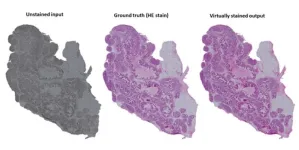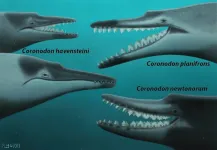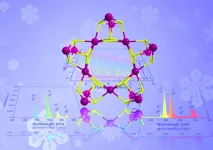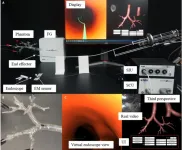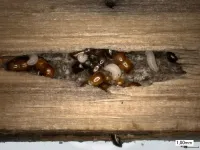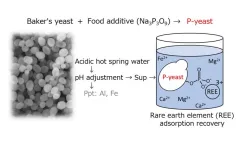(Press-News.org) The researchers of the FinEst Centre for Smart Cities of Tallinn University of Technology (Estonia, Europe) developed the DigiAudit platform to monitor and analyse energy use and indoor climate indicators of buildings and large real estate portfolios in real time. Thinnect, an Estonian IoT start-up company, will help sell the solution and market it worldwide.
We can only reach zero-emission buildings when we have reliable data
The European Union has set a target for all buildings to be zero-emission, or near-zero energy, by 2050. However, there is no reliable data on the energy consumption of many buildings, so it is not possible to monitor the condition of buildings or estimate their energy use. The DigiAudit platform solves this problem and also allows companies to simplify the additional reporting obligations imposed under the European Corporate Sustainability Reporting Directive (CSRD).
In the pilot project, 25 educational buildings in Tallinn and Tartu were connected to the IoT platform. Continuous monitoring of energy, ventilation and air quality in hundreds of buildings generated big data, which analytics were developed to handle. It enables the monitoring and comparison of the condition of the buildings, as well as diagnostics and detection of errors in the technical systems of the buildings and the use of the buildings.
Comparative overview of the energy consumption and indoor climate quality of large real estate portfolios
The platform provides property owners with information on the total energy use, energy costs and carbon footprint of their portfolio of buildings. The energy labels and indoor climate classes of all buildings connected to the platform are also presented, which enables comparison with other similar buildings.
According to DigiAudit's project lead, Professor Jarek Kurnitski, the uniqueness of the solution lies in the real-time energy labeling of the entire real estate portfolio. Improving the energy efficiency of buildings is crucial from the point of view of the Estonia 2035 strategy, as buildings already account for 53% of the final energy consumption. The platform gives building owners and managers a simple, comparable overview of the actual energy consumption of the various buildings in the entire portfolio, as well as the quality of the indoor climate.
In the project, a method was developed to compare the energy efficiency of an individual building with other buildings of the same type. A data set containing energy efficiency indicators of 35,000 Estonian buildings was analyzed. Based on this, a model was developed that approximately shows the energy efficiency of a single building position. As a result of the study, the project team saw that energy efficiency measures to date have improved the performance of buildings, and if progress continues, 73 percent of new or renovated buildings could achieve carbon neutrality.
DigiAudit platform solutions are based on data, and in order to achieve meaningful analysis results, it is crucial to assess the quality of the data. Building ventilation performance and air quality are assessed based on the carbon dioxide level measured in the premises. It turned out that the raw data collected by the installed building automation systems are sometimes unreliable. To solve the problem, a method was developed that corrects the data in such a way that they can be compared with the limit values of the carbon dioxide level specified in the indoor climate standards. Also, a method was made to automatically evaluate whether the room is in use or not. The impact of the methods on the assessment of the indoor climate was important, and the assessment of the period of use is particularly important. If nighttime and weekends are used in the analysis of air quality in schools and kindergartens, the situation appears more positive than it is.
The platform separates capacity monitoring functions from maintenance-related automatic diagnostics. The user interface consists of three views, in which the detail of the information presented depends on the user. Dashboard views were created for the city government, city property board and those responsible for administration/maintenance according to their information needs.
Scientists can solve multifaceted problems
The goal of all pilot projects of FinEst Centre for Smart Cities is to create a functioning product or service that is usable in many cities. DigiAudit is one of the first examples where the goal has been successfully achieved. The cooperation with the start-up company Thinnect has been going on for some time and now the solution has been transferred with a licensing agreement and the first working product has been created.
According to Jürgo Preden, the CEO of Thinnect (the company bringing the solution to the market), DigiAudit is a scientific breakthrough that has no competitor on the market today. ‘Nowadays, no building manager can keep track of where exactly energy is being used because buildings are so complex and their operation changes over time. This is where the DigiAudit system plays an important role – it helps understand where energy is being used and how to reduce the consumption,’ Preden said.
BACKGROUND
Thinnect is a start-up, predominantly owned by Estonian capital, offering IoT technology and services – namely, solutions that enable accurate monitoring and management of buildings. In addition to Estonia, the smart environment solutions of Thinnect are used in eight other countries. The systems developed by the company can be used for saving energy as well as for improving the ease of use and efficiency.
The FinEst Centre for Smart Cities, located at Tallinn University of Technology (Estonia, Europe), has six pilot projects in operation where Estonian and Finnish cities develop and test innovative smart city solutions. The founders of the center are TalTech, Aalto University, the City of Helsinki innovation company Forum Virium and the Ministry of Economic Affairs and Communications. The creation of the center is funded by the European Commission and the Ministry of Education and Research through Horizon 2020 and the European Regional Development Fund.
END
Estonian researchers developed a method for instant energy-performance label
2023-04-14
ELSE PRESS RELEASES FROM THIS DATE:
Researchers developed an AI-based method to replace chemical staining of tissue
2023-04-14
Researchers from the University of Eastern Finland, the University of Turku, and Tampere University have developed an artificial intelligence-based method for virtual staining of histopathological tissue samples as a part of the Nordic ABCAP consortium. Chemical staining has been the cornerstone of studying histopathology for more than a century and is widely applied in, for example, cancer diagnostics.
“Chemical staining makes the morphology of the almost transparent, low-contrast tissue sections visible. Without it, analysing tissue morphology is almost impossible for human vision. Chemical staining is irreversible, and in most ...
Rescuing corneal cells from death with the help of mitochondria
2023-04-14
Québec City, April 14, 2023 - Fuchs' endothelial corneal dystrophy, a degenerative eye disease, causes progressive vision loss that can induce blindness. It is the leading cause of corneal transplantation, but the scarcity of grafts hinders its treatment. A research team from Université Laval and Université de Montréal has identified a way to slow the disease and even avoid transplantation if diagnosed at an early stage.
In people with the disease, the endothelial cells at the back of the cornea die more quickly than in healthy people. "Everyone loses them at a slow rate, slow enough to make it to the end of our lives ...
New specimens and species of the Oligocene toothed baleen whale Coronodon from South Carolina and the origin of Neoceti
2023-04-14
A new study published in the journal PeerJ by Robert W. Boessenecker (CofC), Brian L. Beatty (NYIT), and Jonathan H. Geisler (NYIT) reports a wealth of new fossils of the early toothed baleen whale Coronodon from Oligocene (23-30 million years old) rock layers near Charleston, South Carolina. These include five new skulls, representing two new species: Coronodon planifrons and Coronodon newtonorum, and young juveniles of Coronodon havensteini – first named from a single skull by this team in 2017. Coronodon is one of the most primitive members ...
New family of wheel-like metallic clusters exhibit unique properties
2023-04-14
While the wheel does not need to be reinvented, there are benefits to the development of new nano-wheels, according to a multi-institute research team based in China. The group fabricated a novel family of metallic compounds, each of which exhibit unique properties desirable for next-generation technologies, such as advanced sensors.
Their findings were made available online on March 12 in Polyoxometalates.
“Polymetallic complexes are of great interest not only for their appealing molecular structure but also ...
How drugs get into the blood
2023-04-14
There is a need for new drugs. For example, many of the antibiotics that we have been using for a long time are becoming less effective. Chemists and pharmaceutical scientists are frantically searching for new active substances, especially those that can penetrate cell membranes, as these are the only ones that patients can take orally in the form of a tablet or syrup. Only these active ingredients pass through the intestinal wall in the small intestine and enter the bloodstream to reach the affected area in the body. For active ingredients that cannot penetrate the cell membrane, physicians have no choice but to inject them directly into ...
A novel robotic bronchoscope system for navigation and biopsy of pulmonary lesions
2023-04-14
Cancers are notoriously known for their high mortality rate and increasing incidence worldwide. Among them, lung cancer is arguably one of the most devastating ones. According to the World Cancer Research Fund International, lung cancer was the second most common cancer around the world in 2020, with more than 2.2 million new cases and 1.8 million deaths.
However, lung cancer, like other cancers, is easier to treat if caught earlier. “The reported 1-year survival rate for stage V is just 15% to 19% compared with 81% to 85% for stage I, which means that the early ...
Black cancer patients 71% more likely to experience heart damage following chemotherapy treatment
2023-04-14
Chemotherapy is associated with an increased risk of treatment-related heart damage, including heart failure and cerebrovascular disease, for many patients. But a new meta-analysis, presented at the American College of Cardiology’s Advancing the Cardiovascular Care of the Oncology Patient 2023 conference, finds that Black patients or patients of African ancestry have 71% higher odds of cardiotoxicity following cancer treatment compared to White patients.
Cardiotoxicity is any heart damage stemming from cancer treatment or drugs, including ...
Optica Publishing Group announces launch of Optica Quantum
2023-04-14
WASHINGTON—On World Quantum Day, Optica Publishing Group announced it will begin publishing a new journal in September 2023 dedicated to highly selective results in quantum information science and technology (QIST). The new journal, Optica Quantum, joins the Society’s portfolio of the most-cited journals in optics and photonics and will provide the community with articles of the same exceptional standards for quality, novelty, and significance as its parent journal, Optica.
The concept of quantum light serves as a foundation for many quantum technologies and ongoing ...
Farmer’ beetle finds suitable host trees by tracing scent of its fungus crop
2023-04-14
The alnus ambrosia beetle Xylosandrus germanus, also known as the black stem borer, was accidentally introduced by humans from its native east Asia to North America and Europe around the beginning of the 20th century. X. germanus is a so-called ambrosia beetle, which means that it farms its own food: a specialized fungal symbiont which it ‘sows’ and tends inside the galleries that it digs inside wood. It is a destructive invasive pest, known to attack more than 200 species from 51 families of broadleaf and conifer trees. While it prefers to colonize dead ...
Treasure hunt in hot springs?
2023-04-14
The demand for precious metals and rare earths is expected to continue increasing in the future. Due to limited production areas, recycling from precision equipment and recovering from seawater and hot spring water are needed to ensure a stable supply.
A research group led by Professor Masayuki Azuma and Associate Professor Yoshihiro Ojima of the Osaka Metropolitan University Graduate School of Engineering has successfully developed an adsorbent material that can selectively recover rare earth elements (REEs) using environmentally friendly and inexpensive baker’s yeast and trimetaphosphate, which is used as a food additive.
The research group conducted experiments using ...


